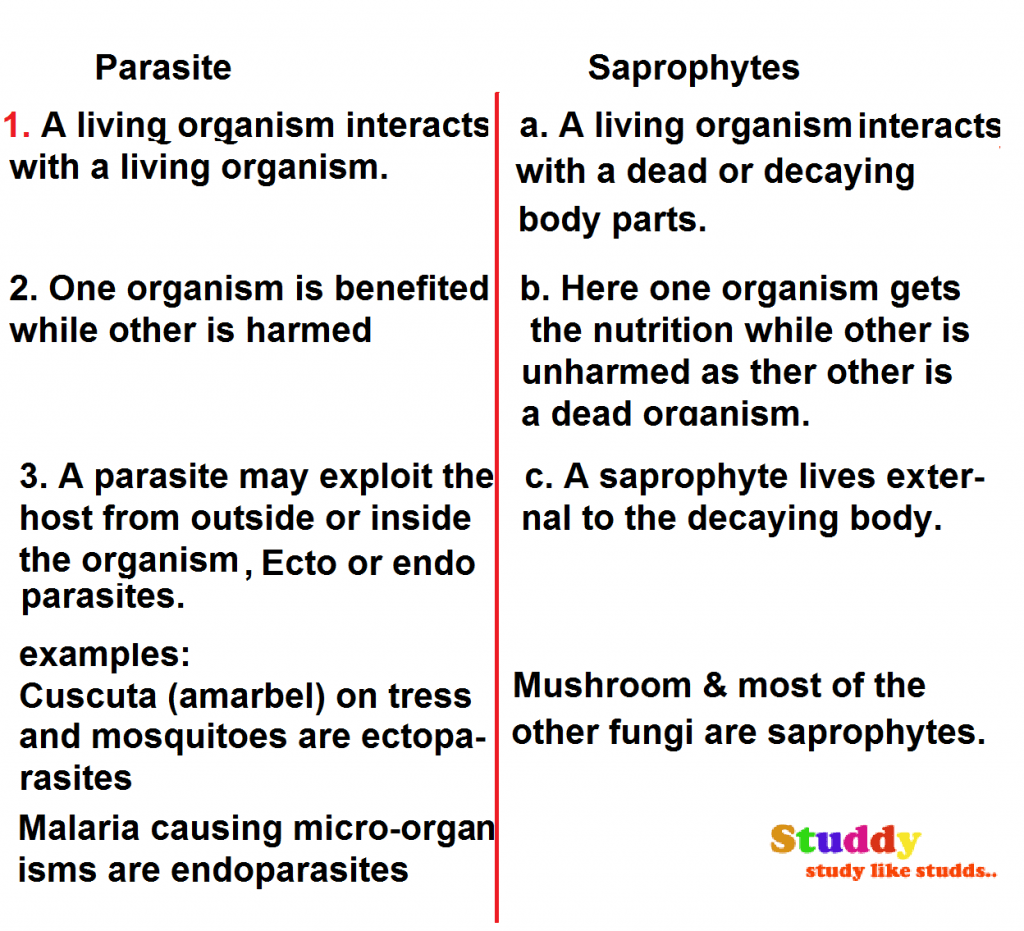NCERT Class 7 Chapter 1 Nutrition in Plants Exercise Question Solution
1. Why do organisms take food?
Every organism requires energy for various life processes like body movement, digestion, respiration, locomotion, etc. Moreover, an organism also grows and repair its damaged body parts. Energy for all these processes comes from the food. The food materials contain nutrients to support all these activities. As a result, the organism takes food.
2. Distinguish between a parasite and a saprophyte.
Parasitism involves the interaction of two living organisms where one gets the benefit, and the other gets harm. In the saprophytic mode of nutrition, an organism gets the nutrient from dead and decaying material.

3. How would you test for the presence of starch?
Iodine solution turns the starch into the blue. So to test material for the presence of starch, we will add some drops of iodine to it. If it turns blue, there is starch in the material. And if iodine solution does not turn to blue, then it means starch is absent in that material.
4. Give a brief description of the process of photosynthesis of food in green plants.
Green plants in the presence of sunlight use carbon dioxide and water from the surrounding and prepare food. We call this process ‘Photosynthesis’.
Green cells of leaves contain a green colour pigment called chlorophyll. It absorbs the sunlight and converts carbon dioxide and water into the food.
Sunlight
Carbon dioxide + Water ———-> Sugar
Chlorophyll
5. Show with the help of a sketch that plants are the ultimate source of energy.
Plant prepare their food by own. Animals and humans eat these plant. So, here source of energy is also the plant. Some animals eat other animals; for example, a lion eats a deer. Here deer gets his food by eating the plant. So, in reality, all the food come from the plants.
6. Fill in the blanks:
a. Green plants are called _____ since they synthesise their food.
b. The food synthesised by the plants is stored as _____.
c. In photosynthesis solar energy is absorbed by the pigment called
______.
d. During photosynthesis, plant take in ______ and release ______ gas.
Answer: a. Autotrophs b. Starch c. Chlorophyll d. Carbon dioxide, Oxygen.
7. Name the following:
a. A parasitic plant with a yellow, slender and branched stem.
b. A partially autotrophic plant.
c. The pores through which leaves exchanges gases.
Answer: a. Cuscuta (amarbel) b. Pitcher plant c. Stomata.
8. Tick the correct:
A. Cuscuta is an example of a. Autotroph b. Parasite c. Saprophyte d. host
B. The plant which traps and feeds on an insect is a. Cuscuta b. China rose c. Pitcher plant d. Rose
Answer: A. Parasite, B. Pitcher plant.
9. Match the item
Chlorophyll: Leaf
Nitrogen: Rhizobium
Cuscuta: Parasite
Animals: Heterotrophs
Insects: Pitcher plant
10. True or False:
a. Carbon dioxide is released during photosynthesis.
b. The plant which synthesises their food is called saprophytes.
c. The product of photosynthesis is not a protein.
d. Solar energy is converted into chemical energy during photosynthesis.
Answer: True: c and d.
False: a & B.
Hint: For a and bread above questions.
c. Plant photosynthesis to form glucose. This glucose is polymerised and stored as starch. Glucose and starch are carbohydrates, not the protein.
d. Conversion of solar energy into glucose is a chemical process. Here electron transfer takes places between carbon dioxide and a water molecule. The process requires energy. Solar light provides this energy to complete the process.
11. Choose the correct option
Which part of the plant takes in carbon dioxide from the air for photosynthesis?
(i) Root hair (ii) Stomata (iii) Leaf veins (iv) Petals.
Answer: Stomata.
12. Choose the correct option from the following:
Plants take carbon dioxide from the atmosphere mainly through their:
(i) roots (ii) stem (iii) flowers (iv) leaves
Answer: Leaves.
13. Why do farmers grow many fruits and vegetable crops inside large greenhouses? What are the advantages to the farmers?
A greenhouse chamber is a chamber where light and heat comes in but can not escape. It provides an artificial medium to control the intensity of light, temperature, humidity, carbon dioxide concentration. Artificial conditions help the farmer to grow crops which can not be developed in the local weather or is prone to diseases. It also helps in increasing the yield. For more details, you can visit this article on Greenhouse chamber.
See also: Paheli Boojho question solution Chapter 1.
Activity explanation chapter 1.
NCERT Class 7 Chapter 2 Nutrition in Animals Exercise solution.
This is a very good way of teaching
NCERT.The features of studdy helps to learn the concept clearly.
Thanks for these amazing resources!